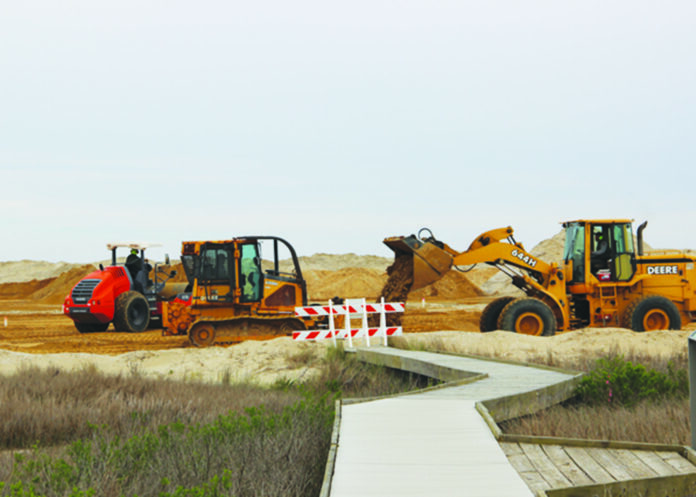
BY CLARA VAUGHN, Eastern Shore Post —
Plans to move the recreational beach at Assateague Island National Seashore have been decades in the making.
The project is one step closer to construction, thanks to $17.7 million in federal funding announced this week.
The money will help build a new access road, parking lot, boardwalks, and paving for a multiuse path to access a wider area of beach just north of the ribbon of public beach now in use, according to a joint release by Sens. Tim Kaine and Mark Warner Monday.
“We are thrilled to see these federal dollars go towards enhancing beach access at Chincoteague and Assateague – a project that will help preserve this natural treasure, provide visitors with a better experience, and generate more economic activity in the region,” the senators said.
“The beach is our lifeline,” said Chincoteague Mayor Arthur Leonard of the seashore that generates an estimated $150 million each year and hosts around 1.5 million visitors, according to the National Park Service.
“We’ve benefitted for 58 years from the beach being a national park and I don’t know what the town would be without it,” he said.
The U.S. Fish and Wildlife Service and National Park Service manage Chincoteague National Wildlife Refuge and Assateague National Seashore.
Fish and Wildlife staff, with Park Service input, applied for a grant last fall through the U.S. Department of Transportation’s Nationally Significant Federal Lands and Tribal Projects Program, which funds the construction, reconstruction, and rehabilitation of nationally significant projects in, beside, or accessing federal and tribal lands.
It is not the first time the agencies sought funding to relocate the recreational beach and its amenities, but it is the first time they succeeded in securing a grant.
The Bipartisan Infrastructure Law reduced minimum project sizes from $25 million to $12.5 million, allowing the Fish and Wildlife Service to secure funding for the first phase of the project.
Funding for the new access road, parking lot, and other amenities is a crucial first step, said Hugh Hawthorne, superintendent of Assateague Island National Seashore in Maryland and Virginia.
“The hardest thing for us to get funded was the roads and the parking, and we’ve got that now,” he said. “If the road’s not there, we can’t do the rest of the project.”
The exact scope of the project’s first phase depends on updating existing cost estimates, said Chincoteague National Wildlife Refuge Manager John Kasbohm.
“It’s still several years down the road,” he said of construction, but planning and permitting can begin once the NSFLTP funds are released in the coming months.
Plans to address Assateague’s shifting shoreline began decades ago. The 1993 Chincoteague National Wildlife Refuge Master Plan directed the Fish and Wildlife Service to coordinate with the Park Service and Town of Chincoteague to “identify a suitable off-site beach parking area to be used once the existing beach parking is lost.”
“It’s not been a surprise that the current beach has been repeatedly damaged and needed repairs,” Kasbohm said.
Barrier islands shift naturally, but the existing recreational beach is situated on “one of the most unstable portions of Assateague island,” he said.
Each year, the National Park Service repairs the parking lot’s almost 1,000 spaces at a cost of between $300,000 and $600,000, Hawthorne said.
“We have to rebuild the parking lot every spring because of storms over the winter,” he said.
“It’s only a matter of time before we have a major storm that completely destroys the location, and so the decision was made that … if we were going to keep a public beach open, we have to move,” he said.
The new recreational beach is roughly 1.5 miles north of the existing national seashore. The island is wider there and offers more stability for the parking lot and other amenities, which will include boardwalks over the dunes, restrooms, showers, changing rooms, lifeguard stands and, eventually, a visitor contact station staffed by the Park Service.
The plans are based on a 20-year-minimum design.
“The infrastructure (for the new site) was kept out of the areas that were most susceptible” Kasbohm said. “We have much more time to deal with Mother Nature and these types of events.”
The move will also take beachgoers farther from piping plover and American oystercatcher habitat, making it “a win-win” for the wildlife refuge and recreational uses, he said.
“After nearly 20 years of work, we are finally seeing money put towards a federal project that has been shovel-ready for over five years,” said Accomack County Supervisor Billy Joe Tarr, whose district includes Chincoteague.
“My thanks is extended to our Honorable Senators Kaine and Warner, as well as the many years the Park Service has kept parking for us and our visitors,” he said.
Hawthorne said the agencies are “confident” they can secure funding to complete future phases of the project.
“The Park Service and Fish and Wildlife Service will be working really hard in the next six months to try to fill in the gaps,” he said.



